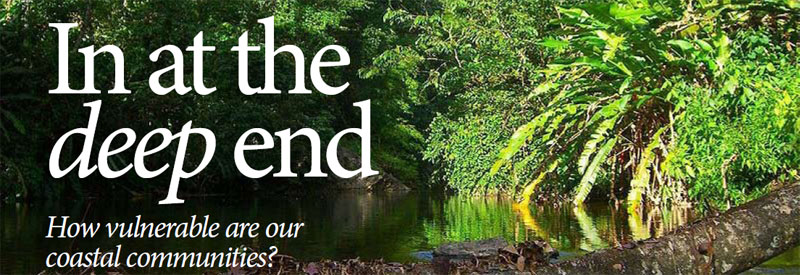
The five-year project, “Managing adaptation to environmental change in coastal communities: Canada and the Caribbean,” received a grant of around Can$2 million (article) after 104 applications were considered and four selected.
Submitted by a multi-disciplinary team led by the Sir Arthur Lewis Institute of Social and Economic Studies (SALI SES) and partner, Canadian Fisheries, Oceans and Aquaculture Management (C-FOAM) at the University of Ottawa, the project proposes to examine climatic changes and their impact on eight communities in the Caribbean and Canada.
The UWI/SALISES team is headed by Professor Patick Watson, and includes researchers Dr Michael Sutherland, Dr Michelle Mycoo, Dr Sandra Sookram, Dr Sonja Teelucksingh, Dr Aldrie Henry-Lee and Martin Franklin. With half of the grant available for the Caribbean aspect of the study, the team, like its Canadian counterpart, has identified four communities within which to locate its work: Grande Rivière, Trinidad; Bequia, Belize Barrier Reef and Georgetown, Guyana.
The teams have developed what might be described as a four-step approach to the project. In a nutshell, said Prof Watson, the idea is to enter communities and identify their assets (“What do they stand to lose?’), then to measure the risks, determine the impact of climate change and finally, to provide projections and mitigation strategies.
It is a complex task, requiring the technical expertise to study climate change and the impact of storms and other related activities, and then the sociological and economic input to relate them to the existing natural, social and economic environment to extrapolate data that could be of planning value.
It is part of the reason that the projects under which the grants fall are viewed as campus-community collaborations. The work will entail research and educational components that affect infrastructure, transportation and utilities, water and sewage distribution and treatment systems, as well as the management of resource sectors in agriculture, aquaculture and fisheries. It is a truly broad scope and it comes from the recognition that the global climate is changing, with sometimes deleterious effects in various regions—and Caribbean states are ranked among the most vulnerable economies in the world.
The team has chosen to study the popular leatherback turtle nesting site, Grande Rivière, on the north coast of Trinidad. This is essentially a small, fishing village subsisting on small crop farming, but is a well known eco-tourism area as it is a protected nesting ground for the turtles. Any changes in sea level will directly affect life in the community, and the team will work with tourism and environmental groups, once it has studied potential threats, to work out mitigating actions.
It will also go into the archipelago of Bequia, whose coral reefs and natural beauty epitomize the universal ideal of “paradise.” Bequia’s reliance on its marine and eco tourism makes it a vital area for this project’s support.
Likewise, the Belize Barrier Reef, island atolls on a 300km section of the second largest reef in the world (the Mesoamerican Barrier Reef System), would have its local tourism and fishing industries suffer should there be storm surges on its reefs.
Once the actual increases or drops in sea levels are determined, it might be possible to provide some real protection for the coastal city of Georgetown in Guyana, which lies 14 ft below sea level, and is currently shielded by the famous Sea Wall.
According to Prof Watson, although there is evidence that the global climate is changing, it is not the intention of the project team to enter the study with presumptions.
“We cannot ignore countervailing opinions in science, we are not assuming any preconceived ideas of outcomes,” he said. “Who knows? We might find nothing.”
Either way, the research is important because among the data to be gathered, will be information gleaned from each partner community on their own specific coping strategies, their ways of life, and what is termed their “resilience factor.”
The Canadian communities are Charlottetown, Prince Edward Island, a coastal port city of historical value, which is threatened by flooding; Iqaluit, Nunavut, a northern city facing possible melting or destabilization of permafrost areas of the shoreline, which could lead to coastal erosion; Gibsons, British Columbia, a resort town largely depending on eco-tourism, which could be at risk for beach erosion and groundwater exposure to desalination, and Isle Madame, Cape Breton, Nova Scotia, another archipelago of coastal communities depending on fishing, aquaculture, and ecotourism.
Prof Watson makes the point that each of these eight communities share substantial characteristics with countless others around the world, and thus the information gathered and the recommended strategies can be shared universally.
The project proposes to build capacity by training university students and community participants in areas relating to coastal environment impacts through regular workshops, seminars, local field work and reports to the communities. Community Adaptation Action Plans will also be formed to provide templates for broader use, and an electronic data base will enable the sharing of information.
The project then, stands to become a global model for ways to evaluate the coastal environmental changes and to do something about it. Funding that comes up to nearly one million Canadian dollars may seem like a lot over the five-year period, but when you consider the scope of work and potential benefits, it may actually be just the tip of the iceberg.
|





